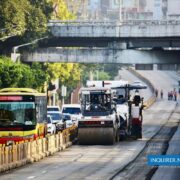‘Manananggal’, ghosts haunt DOH

Health Secretary Teodoro Herbosa couldn’t have picked a more fitting symbol for the public works corruption that has permeated even the health sector. During an inspection this week in Marikina City, he described an abandoned structure where a super health center (SHC) should have been as a “manananggal,” a mythical creature that preys on its victims by sucking their blood or internal organs.
“What should I call this? It’s like a manananggal, right? There’s no upper part, only a lower part,” Herbosa said. The SHC was originally planned to be a two-story facility. However, the local government sought to maximize land use and revised the plan into a four-story building, which would have transformed it into a hospital rather than a village health center. The project, which originally cost only P12 million to build, ballooned into a P180 million undertaking, in addition to the P21.5 million already spent on the first phase. Despite being marked “completed,” it now stands abandoned in a plot that has been taken over by vegetation with rusting steel rebars jutting out of the ground as the only proof of its structure—indeed, quite similar to a manananggal whose upper torso had separated from its lower part so it could prey on its hapless victims.
SHCs, introduced in 2021 by Sen. Christopher “Bong” Go, were envisioned as an improved version of a rural health unit and designed to be more comprehensive than a standard clinic, where people can go for general check-up and minor procedures.
‘Ghost’ health facilities
Last year, the Department of Health (DOH) announced that it had allocated funds for the construction of around 700 SHCs nationwide. In that announcement, it said 18 were to be built in Bulacan, which has become a hotbed for public works corruption, with its district officials allegedly colluding with contractors to defraud billions of pesos meant for flood control projects.
Just how far and deep does this corruption of public works funds go?
Under its health facility enhancement program for fiscal year 2024, the DOH earmarked P1.4 billion for the construction of SHCs. This supposedly funded 878 SHCs based on latest DOH data. As of Oct. 17, 300 were found to be non-operational, 196 were operational, 17 were partially operational, and 365 were under construction. The non-operational SHCs account for a third of the total number of centers built, with 170 of them located in Luzon.
The health secretary has submitted the list of these “ghost” health facilities to the Independent Commission for Infrastructure and has also ordered a probe into the irregularities.
Tip of the iceberg
In defense of the local government, Marikina City Mayor Marcy Teodoro clarified that it was not a “ghost” project and had informed the DOH on Oct. 9 that it was going to proceed with the construction and ensure that the facility would be completed.
He explained that they had no choice but to shoulder the construction expenses because the DOH fell short (may pagkukulang) by failing to release funding for the project’s next phases. A project that was supposed to start in 2021, but only began construction in 2023, and supposedly was completed last year under its new design, should have already raised red flags had the government done a better job in monitoring projects.
The Marikina SHC could only be the tip of the iceberg, as the health chief himself acknowledged that the DOH may have erred in reporting “completed” SHCs. This brings to mind the “ghost” flood control projects and unfinished school buildings and classrooms that have been unraveled in the various investigations into alleged anomalies in public infrastructure.
Participatory audit
Health reform advocate Dr. Tony Leachon called the disclosure “a sobering indictment” of the country’s health care system’s dysfunction. “These centers, envisioned as accessible hubs for primary care, now stand as silent witnesses to bureaucratic failure, wasted public funds, and broken promises. This is not merely a lapse in logistics. It is a systemic failure that demands accountability,” he said in a Facebook post.
The DOH’s plan to establish a citizens’ participatory audit, which allows the public to report potential issues concerning SHCs in their communities, is a step in the right direction to promote accountability. But it should not end up as another performative solution to soothe the public’s growing impatience over the slow pace of investigations unless the purpose is to desensitize Filipinos and make them eventually lose interest.
Sooner, rather than later, the investigating bodies should start prosecuting individuals—the many manananggal behind the widespread theft of taxpayer money. They should not be allowed to get away with sucking funds out of services that can be a matter of life and death, especially for poor Filipinos. Otherwise, these “exposés” will start looking like a badly scripted television drama, with each episode featuring new subplots and corrupt characters but never offering a satisfying ending: jail time.





















PH nutrition programs: Too little, too late